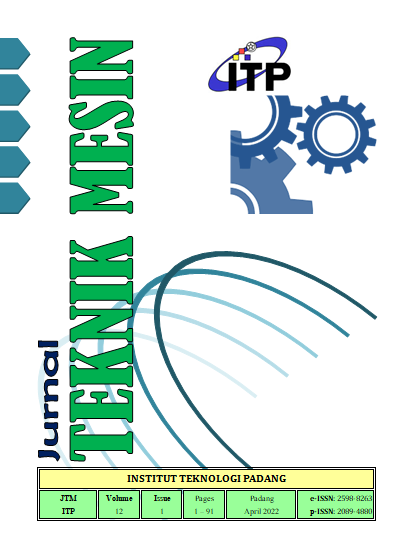Comparison of Propeller Turbine Performance Using Airfoil Blades and Without Airfoil
DOI:
https://doi.org/10.21063/jtm.2022.v12.i1.11-16Kata Kunci:
Blades, Turbine, PerformanceAbstrak
Electricity is a strategic energy resource and is very important for the livelihood of many people. The government has tried to free Indonesia from the electricity crisis and is trying to find alternative uses of new and renewable energy (EBT). The government has committed that NRE will continue to be developed to ensure energy security in Indonesia and meet the growing demand for electricity. The government has set a target of 23% share of clean energy in the national energy mix in 2025 and 31% in 2030 through the National Energy Policy (KEN) and the General National Energy Plan (RUEN). To succeed the government program is to take advantage of the potential energy sources that exist around people's residences. However, one of the obstacles is the remote location so that access is difficult. In addition, the village community lacks knowledge about microhydro technology. Therefore it is necessary to design a turbine that is not complicated to manufacture. The complexity is in the manufacture of turbine blades which must be aerodynamic and affect performance. Therefore, it is necessary to do research on turbine blades that are not aerodynamic and how they perform. This research was conducted experimentally using a propeller turbine and tested on 3 different types of blades, namely, in this study three types of blades were created and designed. The aerodynamic cross-section blade and the square cross-section blade with a thickness of 3 mm without curvature, the blade with a rectangular cross-sectionsquare with a thickness of 2 mm with curvature (camber). which is made of steel plate manufacture by welding. The turbine blade diameter used is 150 mm with a total of 4 blades.
Referensi
B. Pelikan. 2004. Guide On How To Develop A Small Hydropower Plant. ESHA 2004.
R.C. Bryan, and K.V. Sharp, 2013. Impulse Turbine Performance Characteristics And Their Impact On Picohydro Installation, Renewable Energy Journal, Elsevier. 50: 959-964.
T.J. Flaspöhler (2007). Design Of The Runner Of A Kaplan Turbine For Small Hydroelectric Power Plant, University of Applied Sciences, Mechanical engineering Department.
R. Pribadyo dan S. Ahmad, (2006). Perencanaan Dan Pengujian Turbin Propeller Untuk Pembangkit Listrik Tenaga Mikrohidro (Pltmh) Head Rendah, Universitas Teuku Umar, Banda Aceh.
S. Robert and W. Arthur (2011), Design Of Propeller Turbines For Pico Hydro, Notingham, UK.
B. Patrick and Ho-Yan (2012), Design Of A Low Head Pico Hydro Turbine For Rural Electrification In Cameroon, Canada.
E. Permadi (2012), Desain Turbin Turbo Propeller, hanjuang, Jawa Barat.
Unduhan
Diterbitkan
Terbitan
Bagian
Lisensi
Hak Cipta (c) 2022 Marfizal Marfizal, Dedi Wardianto, Sufiyanto Sufiyanto

Artikel ini berlisensiCreative Commons Attribution-NonCommercial-ShareAlike 4.0 International License.


